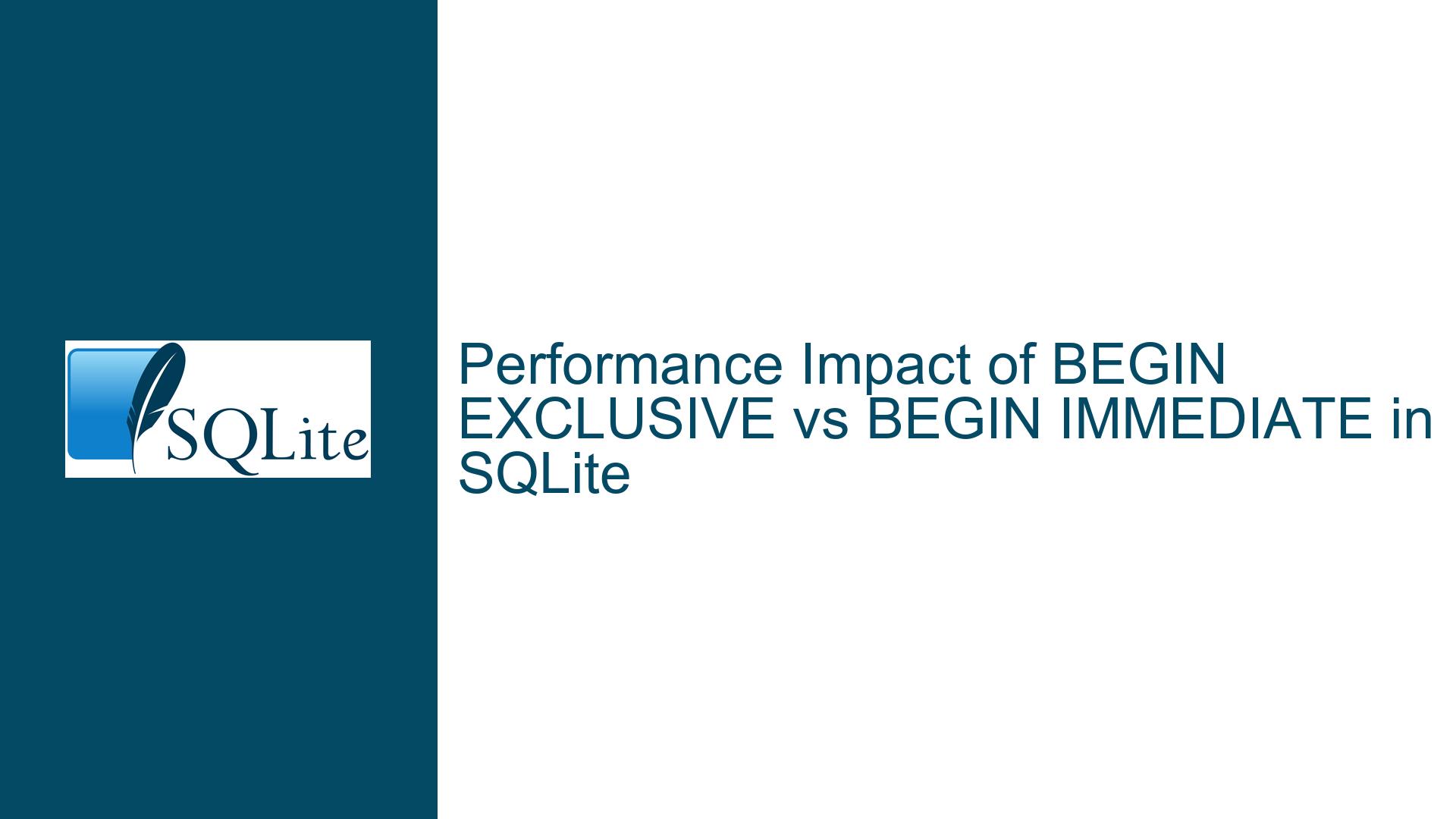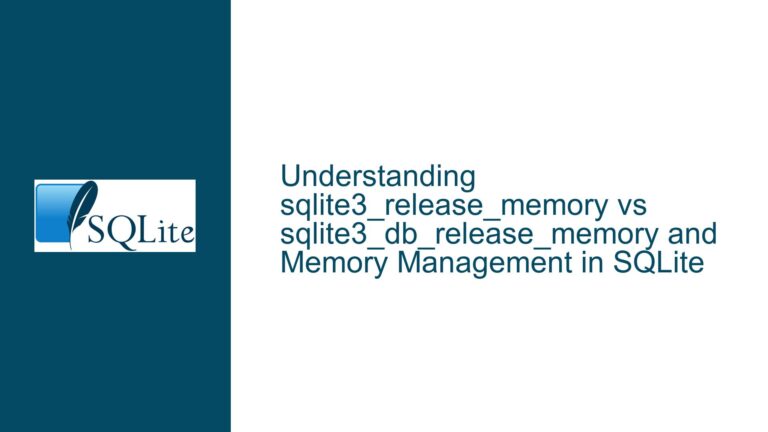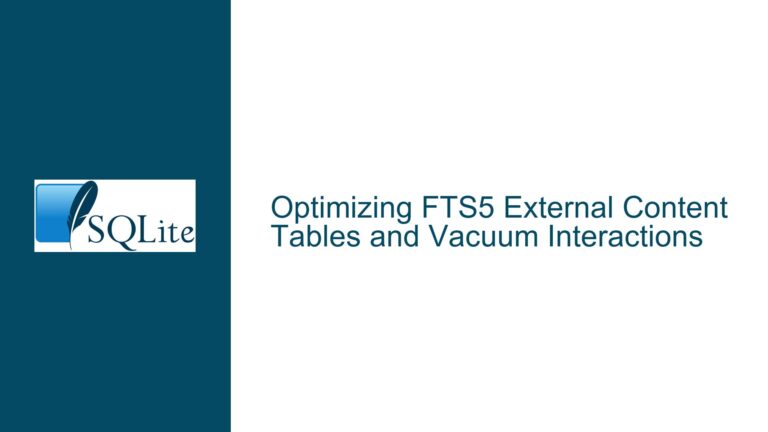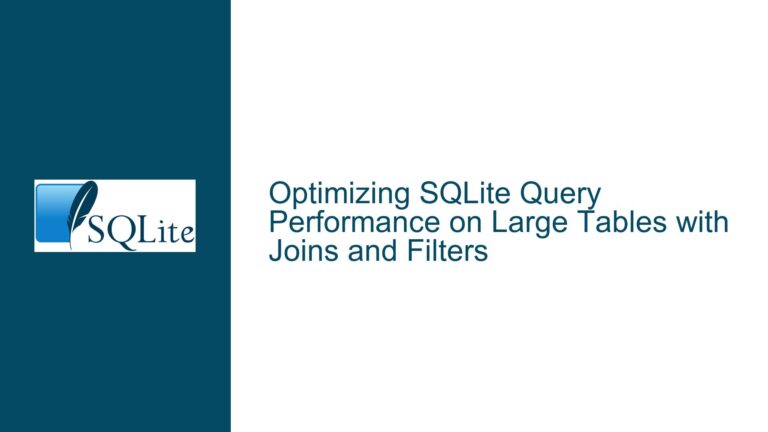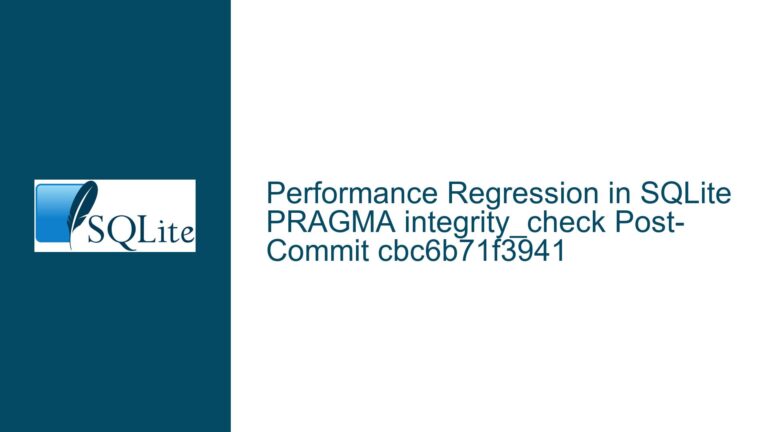Performance Impact of BEGIN EXCLUSIVE vs BEGIN IMMEDIATE in SQLite
Understanding the Performance Implications of BEGIN EXCLUSIVE and BEGIN IMMEDIATE in Non-WAL Mode
When working with SQLite, the choice of transaction modes can have significant implications on performance, especially when dealing with large-scale data operations such as importing millions of rows across multiple tables. The two transaction modes in question, BEGIN EXCLUSIVE and BEGIN IMMEDIATE, are often discussed in the context of their locking behavior and performance characteristics. In non-WAL (Write-Ahead Logging) mode, these two modes exhibit different behaviors, particularly in how they handle file locks and concurrency. This post delves into the nuances of these transaction modes, their impact on performance, and the considerations that should guide your choice between them.
In non-WAL mode, BEGIN IMMEDIATE starts a transaction by acquiring a reserved lock, which allows other connections to read from the database but prevents them from writing. On the other hand, BEGIN EXCLUSIVE acquires an exclusive lock, which prevents other connections from both reading and writing to the database. The key difference lies in the level of isolation and the impact on concurrent access. However, when the database is guaranteed to be accessed by only a single connection, as in the case of a large import process, the performance implications of these modes become a critical consideration.
The Role of File Locking Mechanisms in Transaction Performance
The performance difference between BEGIN EXCLUSIVE and BEGIN IMMEDIATE in non-WAL mode is primarily influenced by the file locking mechanisms employed by SQLite. In non-WAL mode, SQLite uses a combination of shared, reserved, and exclusive locks to manage concurrent access to the database file. When a transaction is started with BEGIN IMMEDIATE, SQLite acquires a reserved lock, which allows other connections to continue reading the database but prevents them from writing. This lock is sufficient to ensure that the transaction can proceed without interference from other writers, but it does not block readers.
In contrast, BEGIN EXCLUSIVE acquires an exclusive lock, which blocks both readers and writers. This lock is more restrictive and ensures that no other connection can access the database while the transaction is in progress. The acquisition of an exclusive lock involves additional system calls and potentially more overhead compared to a reserved lock. However, in a scenario where the database is accessed by only a single connection, the additional overhead of acquiring an exclusive lock may not translate into a noticeable performance difference.
The file locking mechanism in SQLite is implemented using the underlying operating system’s file locking capabilities. On Windows, this typically involves the use of the LockFileEx and UnlockFileEx system calls. The performance impact of these calls can vary depending on the file system and the specific configuration of the operating system. In general, the overhead of acquiring and releasing locks is relatively small compared to the overall cost of the transaction, especially when dealing with large data volumes.
Evaluating Performance in Single-Connection Scenarios
In a single-connection scenario, such as the large import process described, the performance difference between BEGIN EXCLUSIVE and BEGIN IMMEDIATE is likely to be minimal. This is because the primary factor affecting performance in this context is the efficiency of the data import process itself, rather than the locking behavior of the transaction. The import process involves a series of operations, including parsing the input data, preparing and executing SQL statements, and committing the transaction. The time spent on these operations far outweighs the time spent on acquiring and releasing locks.
However, there are some subtle differences that could influence the choice between BEGIN EXCLUSIVE and BEGIN IMMEDIATE. For example, BEGIN EXCLUSIVE may provide a slight performance advantage in scenarios where the transaction involves a large number of write operations. This is because the exclusive lock ensures that no other connection can attempt to read the database, which could otherwise lead to contention and additional overhead. On the other hand, BEGIN IMMEDIATE may be more efficient in scenarios where the transaction involves a mix of read and write operations, as it allows other connections to continue reading the database.
Another consideration is the potential impact of system calls on performance. Acquiring an exclusive lock involves additional system calls compared to a reserved lock, which could introduce some overhead. However, this overhead is generally small and may not be noticeable in the context of a large import process. In practice, the performance difference between BEGIN EXCLUSIVE and BEGIN IMMEDIATE is likely to be negligible in a single-connection scenario.
Optimizing Transaction Performance in Non-WAL Mode
To optimize transaction performance in non-WAL mode, it is important to consider the specific requirements of your application and the characteristics of your data. If your application involves a large import process that is guaranteed to run without any other connections accessing the database, the choice between BEGIN EXCLUSIVE and BEGIN IMMEDIATE is unlikely to have a significant impact on performance. However, there are several other factors that can influence transaction performance and should be taken into account.
One important factor is the size of the transaction. Large transactions that involve a high volume of data can put significant strain on the database and lead to performance degradation. To mitigate this, it is often beneficial to break the import process into smaller batches, each wrapped in its own transaction. This approach reduces the amount of data that needs to be processed in a single transaction and can help to improve overall performance.
Another factor to consider is the efficiency of the SQL statements used in the import process. Poorly optimized SQL statements can lead to slow performance and increased resource consumption. It is important to ensure that the SQL statements are properly indexed and that any unnecessary operations are avoided. For example, using prepared statements can help to reduce the overhead of parsing and compiling SQL statements, leading to faster execution times.
In addition to optimizing the SQL statements, it is also important to consider the configuration of the SQLite database. For example, increasing the page size of the database can improve performance by reducing the number of I/O operations required to read and write data. Similarly, enabling the synchronous pragma can help to ensure that data is written to disk in a timely manner, reducing the risk of data loss in the event of a crash.
Finally, it is important to monitor the performance of the import process and make adjustments as needed. This can involve using tools such as the SQLite command-line interface or third-party performance monitoring tools to track the execution time of SQL statements and identify any bottlenecks. By carefully monitoring and optimizing the import process, it is possible to achieve significant performance improvements and ensure that the database operates efficiently.
Conclusion
In conclusion, the choice between BEGIN EXCLUSIVE and BEGIN IMMEDIATE in non-WAL mode is unlikely to have a significant impact on performance in a single-connection scenario, such as a large import process. The primary factors affecting performance in this context are the efficiency of the data import process, the size of the transaction, and the optimization of SQL statements. While BEGIN EXCLUSIVE may provide a slight performance advantage in some scenarios, the difference is generally small and may not be noticeable in practice.
To optimize transaction performance in non-WAL mode, it is important to consider the specific requirements of your application and the characteristics of your data. Breaking the import process into smaller batches, optimizing SQL statements, and configuring the SQLite database appropriately can all help to improve performance. By carefully monitoring and optimizing the import process, it is possible to achieve significant performance improvements and ensure that the database operates efficiently.
In summary, while the choice between BEGIN EXCLUSIVE and BEGIN IMMEDIATE is an important consideration in multi-connection scenarios, it is less critical in single-connection scenarios. The key to optimizing performance in non-WAL mode lies in understanding the specific requirements of your application and taking a holistic approach to performance tuning. By focusing on the factors that have the greatest impact on performance, you can ensure that your SQLite database operates efficiently and effectively, even when dealing with large volumes of data.
